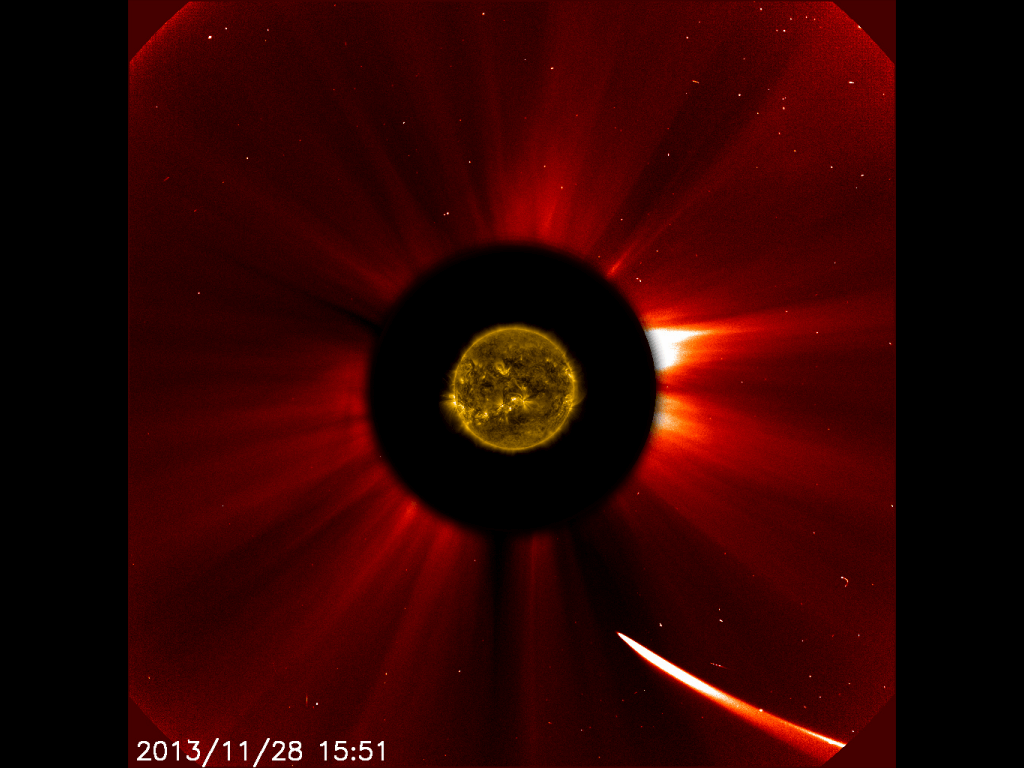NASA's SDO spacecraft, which observes solar comets and focused on Comet Ison, failed to locate it after it passed behind the Sun, as NASA broadcast in a Twitter message * Yesterday the comet behaved strangely - it became bright for a few hours and then faded. This is probably when it began to crumble from the inside until the sun evaporated most of what was left
A NASA video depicting from different angles - each from a different spacecraft - the disintegration of Comet Ison as it approaches the Sun

09: 39 Update
Bill Plate explained on the blog "Bad Astronomy" Because it is reasonable to assume that few remnants will continue to appear in the images and added: "The comet existed for a long time, it became very bright last night, paled this morning (probably due to disintegration from inside AB), and finally disintegrated into pieces. This is not surprising. We often see comets disintegrating as they orbit the sun. ISON's crater is a few kilometers in diameter at best, so it suffered from the sun's heat far more than a large comet would survive. Still, observations remain to be made and it is also possible to study the data already accumulated on the comet from the previous observations of it.
Midnight update - 29/11/2013
NASA announced in tweets on Twitter in the last hour that Comet Ison, which for the last year at least was considered a comet that was expected to become very bright due to the large amount of material that might have evaporated during its first pass near the Sun, will not deliver the goods. It probably fell apart. However, at NASA they go through all the images taken by the SDO spacecraft.
"We didn't see Comet Ison after it passed the Sun". The NASA tweeters compared the fate of the comet to that of Icarus. "Apparently Iason got too close to the sun."
22:00
Two NASA spacecraft photographed the comet a few hours before it passed the Sun
NASA's SOHO (Solar and Heliospheric Observatory) spacecraft and the European Space Agency and NASA's Solar Dynamics Observatory (SDO) photographed comet Ison this morning (10:51 EST, 17:51 Israel time) just before it passes closest to the sun.
The two spacecraft are part of a fleet of spacecraft that study the Sun at different wavelengths and examine the sunspots, its flames, the solar corona, the solar wind and more.
We will add and update mainly on the interesting issue of what happened to the comet after passing near the Sun, and of course whether it will become a bright comet.
Recall Matthew Knight, an astronomer at Lovell Observatory and a member of NASA's observing campaign Comet ISON lays out some of the possibilities for us. The disintegration of the comet near the sun was his second scenario: "The comet moves very fast, so it will not stay long in such extreme temperatures. Unfortunately for Iason, he faces a double trap due to his proximity to the sun. Even if it survives the rapid evaporation of its outer part, it may get close enough to the Sun for its gravity to tear it apart.”
Previous reports on the science website:
- 29/11/2013 Comet Ison disintegrated as it approached the Sun * Experts: It disintegrated from the inside in the hours preceding its passage by the Sun
- 24/11/2013 Comet Ison is already visible in the morning, will we see it in the evening from Thursday?
- 15/11/2013 What is the expected fate of Comet Ison in the next two weeks?


3 תגובות
I photographed the sun at sunset when the comet was supposed to pass by her. You can clearly see a glowing bump in the lower left where the comet should have exited. I wonder if it's the comet or its disintegration?
https://www.facebook.com/golanjonathan
It is still possible that the comet survived, at least in part, or in several parts. An astronomer claims to have spotted a tail near where the comet was expected to exit.
In the case of breaking up into several parts, it is difficult to predict the flight paths of all the parts in advance, which is true - it is easier to identify the tails of a comet (if any) because they extend to large dimensions.